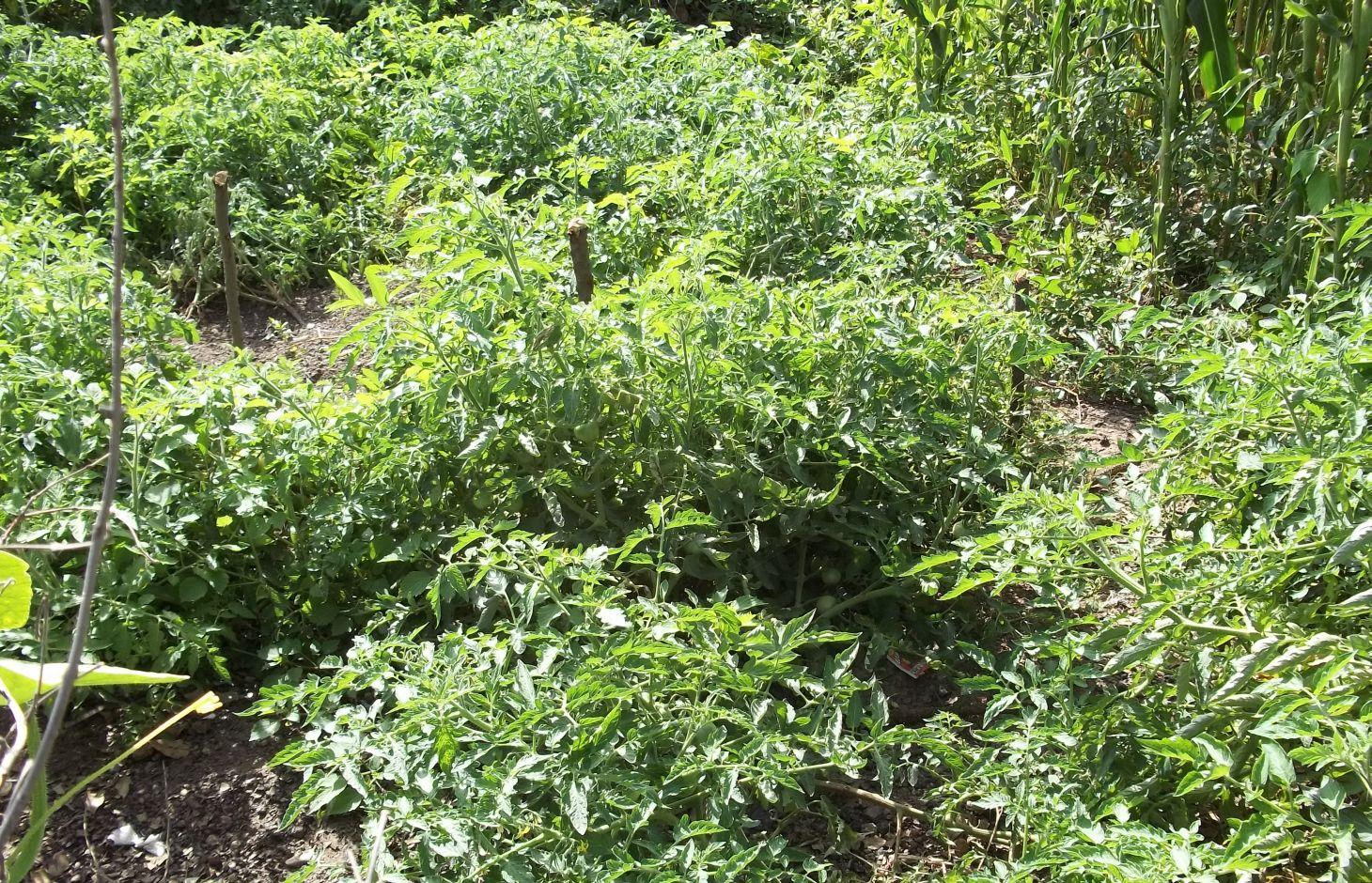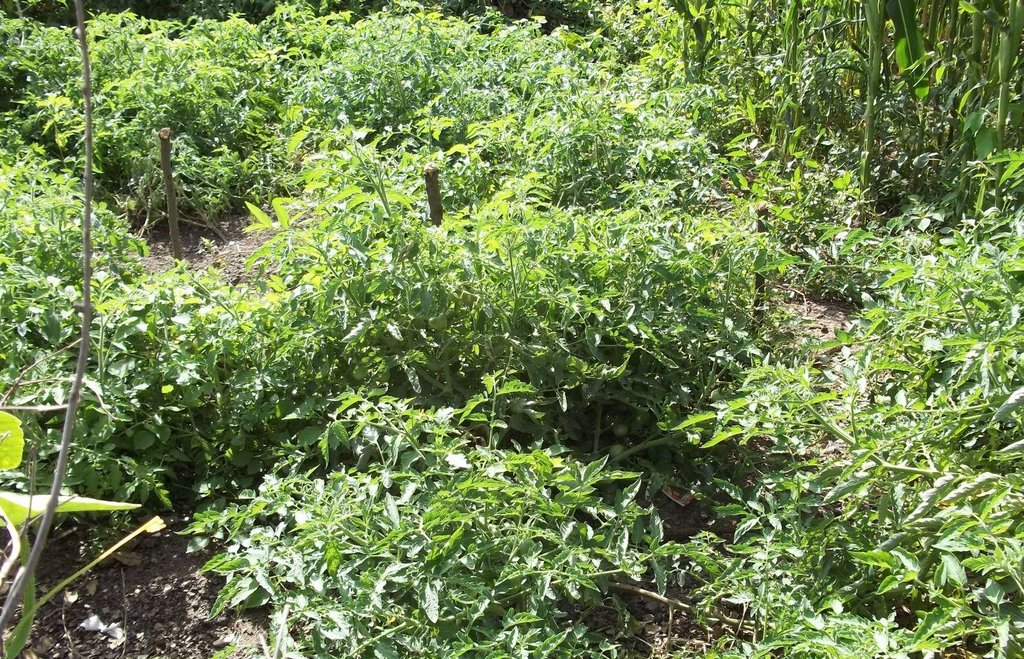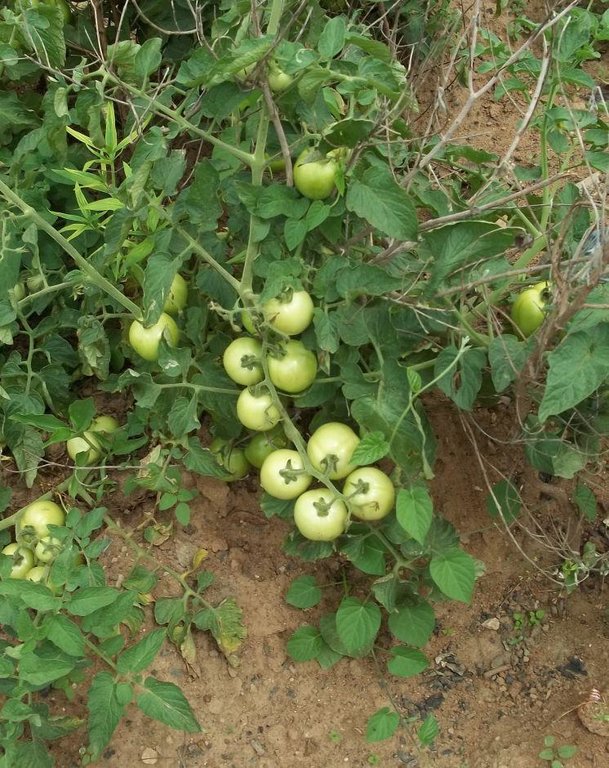Introducing tomato varieties using succession planting [马里]
- 创建:
- 更新:
- 编制者: Dieter Nill
- 编辑者: –
- 审查者: Deborah Niggli
Introduction des variétés de tomates d’un cycle cultural échelonné (French)
technologies_1636 - 马里
查看章节
全部展开 全部收起1. 一般信息
1.2 参与该技术评估和文件编制的资源人员和机构的联系方式
SLM专业人员:
Dako Jean Parfait
parfaitdako@yahoo.fr
National Directorate of Agriculture
马里
有助于对技术进行记录/评估的项目名称(如相关)
Manual of Good Practices in Small Scale Irrigation in the Sahel (GIZ )有助于对技术进行记录/评估的机构名称(如相关)
Deutsche Gesellschaft für Internationale Zusammenarbeit (GIZ) GmbH (GIZ) - 德国1.3 关于使用通过WOCAT记录的数据的条件
(现场)数据是什么时候汇编的?:
01/07/2012
编制者和关键资源人员接受有关使用通过WOCAT记录数据的条件。:
是
1.4 所述技术的可持续性声明
这里所描述的技术在土地退化方面是否存在问题,导致无法被认为是一种可持续的土地管理技术?:
否
2. SLM技术的说明
2.1 技术简介
技术定义:
Increasing the revenues of growers through the production of off-season tomatoes
2.2 技术的详细说明
说明:
Tomato production in the off-season is restricted by the prevalence of insects and disease at that time. To mitigate these difficulties, it is important to find sustainable, non-polluting solutions that are accessible to producers. These solutions are: good tomato growing practices, the use of resilient and suitable tomato varieties, and biological control. Some varieties of off-season tomatoes have produced well and shown a certain resilience to diseases and other pests (nematodes and aphids). Growing tomatoes off season also means the market can be supplied when such produce is lacking.
The specific objectives of growing off-season tomatoes are: promoting market garden production during the off-season; reducing the scarcity of tomatoes in the off-season; increasing the revenues of growers. The average yield obtained from each crop is around 15,500 kilograms per ha, with yields peaking at 35,500 kilograms per ha in some places.
Implementation: 1) Select a site for the nursery that is near to a water source. Clean and turn the soil in the plot. The insects and weeds in the soil often pass on disease to young nursery plants. It is therefore necessary to disinfect the soil. Manure must be worked into the soil or compost prior to disinfection. In the week prior to treatment, the nursery soil must be kept sufficiently moist. Growers can disinfect their soil with fire, hot water, or chemical products. 2) The way a bed is prepared depends on the season. In the dry season, the nursery bed is sunk into the ground so that it holds water better. In the rainy season, the nursery bed is raised (mounded) to prevent waterlogging and promote good drainage once the rains have abated. 3) Seed requirement: Two to three grams for each 100-square-metre plot. Fresh market tomatoes: 300 grams per hectare. Industrial tomatoes: 400 grams per hectare. 4) Fertilisers are optional. During sowing, they can be applied in small quantities in soluble form. Alternatively, three kg of well-rotted manure can be applied per square metre. 5) Protecting plants: Combat leafminers and prevent damping off by applying authorised plant health products. Cover the nursery with a mosquito net until the seedlings are planted out. 6) Seedbeds are laid out in rows 15 to 20 centimetres apart. The seeds are sown along one-centimetre-deep furrows or simply scattered. Seed density should be 100 per linear metre, i.e. 500 per square metre. The seeds are then covered with earth or fine sand. The beds are covered with straw, which is removed as soon as the seedlings sprout. Duration of nursery stage: three to four weeks. 7) Healthy and strong plants with at least six proper leaves are planted out. The distance required between plants varies according to the season, growing conditions and varieties in question: 80 x 60 cm; 80 x 40 cm; 60 x 60 cm; 60 x 40 cm. When transplanting plants, compact the earth around the roots. Each plant must be carefully extracted along with the clump of earth its roots are embedded in. Dig a hole in the bed and insert the plant. Plants are planted in raised beds or mounds in the rainy season and in the beds or flat ploughed ground outside of the rainy season. Transplanting should be carried out at the end of the day, when it is cooler. Water plants immediately after planting them out. Whatever the growing season, it is best to cover young, freshly transplanted plants with a straw cover providing adequate shade. If some plants die, replace them with others held in the nursery. 8) How to prune tomato plants: Remove buds growing between the leaf and the stalk. Retain only one or two thick stalks with their leaves and their flowers. Pruning should be carried out once or twice a month. Prune tomato plants whose fruit will be used for industrial purposes or canned (determinate tomatoes may not be pruned). From time to time, remove suckers (a side shoot from an axillary bud) when weeding and hoeing. For fast-growing varieties, retain just one thick stalk. 9) The quantities of chemical fertiliser to apply vary as follows: 40 to 120 kilograms of nitrogen per ha, 30 to 90 kilograms of phosphate per ha, and 30 to 90 kilograms of potash per ha. Never spray fertilisers on young or wet plants as this will burn them. An alternative is 20 to 30 tonnes of organic fertiliser per ha 10) Plant care: Plants must be watered regularly (morning and evening), particularly during fruit formation. The water quantities are then reduced towards the end of the growing cycle. Weed and hoe regularly, especially in the early stages of planting. Stake the tomato cultivars before they begin forming fruit. This will stop the fruits touching the ground. Using mulch provides better quality fruit.
2.3 技术照片
2.5 已应用该技术的、本评估所涵盖的国家/地区/地点
国家:
马里
区域/州/省:
Mali
有关地点的进一步说明:
Kayes, Koulikoro, Sikasso, Ségou, Mopti, Bamako
2.6 实施日期
如果不知道确切的年份,请说明大概的日期:
- 不到10年前(最近)
2.7 技术介绍
详细说明该技术是如何引入的:
- 通过项目/外部干预
注释(项目类型等):
Ongoing for three years
3. SLM技术的分类
3.1 该技术的主要目的
- 改良生产
3.2 应用该技术的当前土地利用类型

农田
- 一年一作
注释:
Major land use problems (compiler’s opinion): Tomato production in the off-season is restricted by the prevalence of insects and disease at that time, scarcity of tomatoes in the off-season
3.3 有关土地利用的更多信息
该技术所应用土地的供水:
- 混合雨水灌溉
每年的生长季节数:
- 1
具体说明:
Longest growing period in days: 120; Longest growing period from month to month: August-November
3.4 该技术所属的SLM组
- 病虫害综合管理(包括有机农业)
3.5 技术传播
注释:
Total area covered by the SLM Technology is 0.75 m2.
The succession planting programme for the 2010/11 and 2011/12 growing seasons covered a total of 40 circles in six regions (Kayes, Koulikoro, Sikasso, Ségou and Mopti and Bamako District). Farming advisors cascaded training to 1,200 producers who own succession-planted plots. Each succession plot is 400 square metres in size. In total, 75 hectares have been sown by producers.
3.6 包含该技术的可持续土地管理措施

植物措施
- V1:乔木和灌木覆盖层
注释:
Type of vegetative measures: scattered / dispersed
3.7 该技术强调的主要土地退化类型

生物性退化
- Bp:害虫/疾病增加,捕食者减少
注释:
Main causes of degradation: other natural causes (avalanches, volcanic eruptions, mud flows, highly susceptible natural resources, extreme topography, etc.) specify (insects and diseases)
3.8 防止、减少或恢复土地退化
具体数量名该技术与土地退化有关的目标:
- 减少土地退化
4. 技术规范、实施活动、投入和成本
4.1 该技术的技术图纸
4.2 技术规范/技术图纸说明
Raised bed (15 to 20 centimetres high). In the rainy season, the nursery bed is raised (mounded) to prevent waterlogging and promote good drainage once the rains have abated. In the dry season, the nursery bed is sunk into the ground so that it holds water better.
Technical knowledge required for field staff / advisors: high
Technical knowledge required for land users: low
Main technical functions: promotion of vegetation species and varieties (quality, eg palatable fodder), use of resilient and suitable tomato varieties
Scattered / dispersed
Vegetative material: F : fruit trees / shrubs
4.4 技术建立活动
| 活动 | 措施类型 | 时间 | |
|---|---|---|---|
| 1. | Select a site for the nursery that is near to a water source | 植物性的 | |
| 2. | disinfect the soil | 植物性的 | |
| 3. | sowing of seeds | 植物性的 | |
| 4. | Fertilisers are optional. During sowing, they can be applied in small quantities in soluble form | 植物性的 | |
| 5. | Cover the nursery with a mosquito net until the seedlings are planted out | 植物性的 |
4.6 维护/经常性活动
| 活动 | 措施类型 | 时间/频率 | |
|---|---|---|---|
| 1. | Healthy and strong plants with at least six proper leaves are planted out | 植物性的 | |
| 2. | When transplanting plants, compact the earth around the roots. Each plant must be carefully extracted along with the clump of earth its roots are embedded in | 植物性的 | |
| 3. | Dig a hole in the bed and insert the plant. | 植物性的 | |
| 4. | Water plants immediately after planting them out | 植物性的 | |
| 5. | cover young, freshly transplanted plants with a straw cover providing adequate shade. | 植物性的 | |
| 6. | If some plants die, replace them with others held in the nursery | 植物性的 | |
| 7. | prune tomato plants | 植物性的 | |
| 8. | Plants must be watered regularly (morning and evening), particularly during fruit formation. | 植物性的 | |
| 9. | Weed and hoe regularly, especially in the early stages of planting. Stake the tomato cultivars before they begin forming fruit | 植物性的 |
4.8 影响成本的最重要因素
描述影响成本的最决定性因素:
Economic analysis of off-season tomato production from 2012 to 2013:
Total area sown with off-season tomato: 175 hectares
Quantity of off-season tomatoes grown: 4,300 tonnes
Price of tomatoes grown in season: 170 to 200 CFA francs per kilogram
Price of tomatoes grown off season: 600 to 800 CFA francs per kilogram
Each grower produces an average 650 kilograms on a succession plot, with some producing up to 1,400 kilograms. Produce from the plots has earned growers between 300,000 and 630,000 CFA francs (gross) over the winter season, with 75% of production sold at 600 CFA francs per kilogram.
5. 自然和人文环境
5.1 气候
年降雨量
- < 250毫米
- 251-500毫米
- 501-750毫米
- 751-1,000毫米
- 1,001-1,500毫米
- 1,501-2,000毫米
- 2,001-3,000毫米
- 3,001-4,000毫米
- > 4,000毫米
农业气候带
- 半干旱
Thermal climate class: tropics
5.2 地形
平均坡度:
- 水平(0-2%)
- 缓降(3-5%)
- 平缓(6-10%)
- 滚坡(11-15%)
- 崎岖(16-30%)
- 陡峭(31-60%)
- 非常陡峭(>60%)
地形:
- 高原/平原
- 山脊
- 山坡
- 山地斜坡
- 麓坡
- 谷底
垂直分布带:
- 0-100 m a.s.l.
- 101-500 m a.s.l.
- 501-1,000 m a.s.l.
- 1,001-1,500 m a.s.l.
- 1,501-2,000 m a.s.l.
- 2,001-2,500 m a.s.l.
- 2,501-3,000 m a.s.l.
- 3,001-4,000 m a.s.l.
- > 4,000 m a.s.l.
5.3 土壤
平均土层深度:
- 非常浅(0-20厘米)
- 浅(21-50厘米)
- 中等深度(51-80厘米)
- 深(81-120厘米)
- 非常深(> 120厘米)
土壤质地(表土):
- 中粒(壤土、粉土)
- 细粒/重质(粘土)
表土有机质:
- 中(1-3%)
- 低(<1%)
5.4 水资源可用性和质量
地下水位表:
5-50米
地表水的可用性:
中等
水质(未处理):
仅供农业使用(灌溉)
5.5 生物多样性
物种多样性:
- 中等
5.6 应用该技术的土地使用者的特征
生产系统的市场定位:
- 混合(生计/商业
非农收入:
- 收入的10-50%
相对财富水平:
- 贫瘠
- 平均水平
机械化水平:
- 手工作业
性别:
- 男人
说明土地使用者的其他有关特征:
Population density: < 10 persons/km2
Annual population growth: 2% - 3%
10% of the land users are rich.
50% of the land users are average wealthy.
30% of the land users are poor.
10% of the land users are very poor.
5.7 应用该技术的土地使用者拥有或租用的平均土地面积
- < 0.5 公顷
- 0.5-1 公顷
- 1-2 公顷
- 2-5公顷
- 5-15公顷
- 15-50公顷
- 50-100公顷
- 100-500公顷
- 500-1,000公顷
- 1,000-10,000公顷
- > 10,000公顷
这被认为是小规模、中规模还是大规模的(参照当地实际情况)?:
- 小规模的
5.8 土地所有权、土地使用权和水使用权
注释:
The irrigated land is allocated by the chief
5.9 进入服务和基础设施的通道
健康:
- 贫瘠
- 适度的
- 好
教育:
- 贫瘠
- 适度的
- 好
技术援助:
- 贫瘠
- 适度的
- 好
就业(例如非农):
- 贫瘠
- 适度的
- 好
市场:
- 贫瘠
- 适度的
- 好
能源:
- 贫瘠
- 适度的
- 好
道路和交通:
- 贫瘠
- 适度的
- 好
饮用水和卫生设施:
- 贫瘠
- 适度的
- 好
金融服务:
- 贫瘠
- 适度的
- 好
6. 影响和结论性说明
6.1 该技术的现场影响
社会经济效应
收入和成本
农业收入
社会文化影响
食品安全/自给自足
冲突缓解
contribution to human well-being
注释/具体说明:
Some varieties of off-season tomatoes have produced well and shown a certain resilience to diseases and other pests (nematodes and aphids). Growing tomatoes off season also means the market can be supplied when such produce is lacking. The average yield obtained from each crop is around 15,500 kilograms per ha, with yields peaking at 35,500 kilograms per ha in some places.
生态影响
土壤
土壤覆盖层
生物多样性:植被、动物
生物量/地上C
植物多样性
害虫/疾病控制
6.3 技术对渐变气候以及与气候相关的极端情况/灾害的暴露和敏感性(土地使用者认为的极端情况/灾害)
渐变气候
渐变气候
| 季节 | 气候变化/极端天气的类型 | 该技术是如何应对的? | |
|---|---|---|---|
| 年温度 | 增加 | 好 |
气候有关的极端情况(灾害)
气象灾害
| 该技术是如何应对的? | |
|---|---|
| 局地暴雨 | 好 |
| 局地风暴 | 好 |
气候灾害
| 该技术是如何应对的? | |
|---|---|
| 干旱 | 好 |
水文灾害
| 该技术是如何应对的? | |
|---|---|
| 比较和缓的(河道)洪水 | 好 |
其他气候相关的后果
其他气候相关的后果
| 该技术是如何应对的? | |
|---|---|
| 缩短生长期 | 好 |
6.4 成本效益分析
技术收益与技术建立成本相比如何(从土地使用者的角度看)?
短期回报:
非常积极
长期回报:
非常积极
技术收益与技术维护成本/经常性成本相比如何(从土地使用者的角度看)?
短期回报:
非常积极
长期回报:
非常积极
6.7 该技术的优点/长处/机会
| 编制者或其他关键资源人员认为的长处/优势/机会 |
|---|
| some varieties of off-season tomatoes have produced well and shown a certain resilience to diseases and other pests (nematodes and aphids). |
| reduction of the scarcity of tomatoes in the off-season |
| Growing tomatoes off season also means the market can be supplied when such produce is lacking |
| The possibility of selling tomatoes during the winter season is very useful for restarting and increasing production. Growers are very enthusiastic about the technology. |
6.8 技术的弱点/缺点/风险及其克服方法
| 编制者或其他关键资源人员认为的弱点/缺点/风险 | 如何克服它们? |
|---|---|
| availability of inputs and farming advisors for carrying out the practice |
7. 参考和链接
7.1 信息的方法/来源
- 实地考察、实地调查
- 与土地使用者的访谈
7.2 参考可用出版物
标题、作者、年份、ISBN:
Manual of Good Practices in Small Scale Irrigation in the Sahel. Experiences from Mali. Published by GIZ in 2014.
可以从哪里获得?成本如何?
http://star-www.giz.de/starweb/giz/pub/servlet.starweb
标题、作者、年份、ISBN:
DNA (2012): Data sheet on growing off-season tomatoes
标题、作者、年份、ISBN:
DNA (2013): Detailed report, West Africa Agricultural Productivity Program (WAAPP)
链接和模块
全部展开 全部收起链接
无链接
模块
无模块





